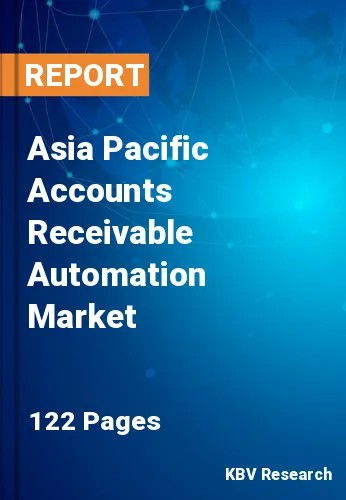Chapter 1. Market Scope & Methodology
1.1 Market Definition
1.2 Objectives
1.3 Market Scope
1.4 Segmentation
1.4.1 Asia Pacific Accounts Receivable Automation Market, by Component
1.4.2 Asia Pacific Accounts Receivable Automation Market, by Vertical
1.4.3 Asia Pacific Accounts Receivable Automation Market, by Deployment Type
1.4.4 Asia Pacific Accounts Receivable Automation Market, by Organization Size
1.4.5 Asia Pacific Accounts Receivable Automation Market, by Country
1.5 Methodology for the research
Chapter 2. Market Overview
2.1 Introduction
2.1.1 Overview
2.1.1.1 Market composition and scenario
2.2 Key Factors Impacting the Market
2.2.1 Market Drivers
2.2.2 Market Restraints
Chapter 3. Competition Analysis - Global
3.1 KBV Cardinal Matrix
3.2 Recent Industry Wide Strategic Developments
3.2.1 Partnerships, Collaborations and Agreements
3.2.2 Product Launches and Product Expansions
3.2.3 Acquisition and Mergers
3.3 Top Winning Strategies
3.3.1 Key Leading Strategies: Percentage Distribution (2018-2022)
3.3.2 Key Strategic Move: (Acquisitions and Mergers: 2019, Dec – 2022, Jan) Leading Players
Chapter 4. Asia Pacific Accounts Receivable Automation Market by Component
4.1 Asia Pacific Solution Market by Country
4.2 Asia Pacific Services Market by Country
4.3 Asia Pacific Accounts Receivable Automation Market by Services Type
4.3.1 Asia Pacific Professional Market by Country
4.3.2 Asia Pacific Managed Market by Country
Chapter 5. Asia Pacific Accounts Receivable Automation Market by End-User
5.1 Asia Pacific BFSI Market by Country
5.2 Asia Pacific Energy & Utilities Market by Country
5.3 Asia Pacific Manufacturing Market by Country
5.4 Asia Pacific Telecom & IT Market by Country
5.5 Asia Pacific Retail & Consumer Goods Market by Country
5.6 Asia Pacific Healthcare & Life Sciences Market by Country
5.7 Asia Pacific Other End-User Market by Country
Chapter 6. Asia Pacific Accounts Receivable Automation Market by Deployment Type
6.1 Asia Pacific On-premise Market by Country
6.2 Asia Pacific Cloud Market by Country
Chapter 7. Asia Pacific Accounts Receivable Automation Market by Organization Size
7.1 Asia Pacific Large Enterprises Market by Country
7.2 Asia Pacific Small & Medium Enterprises Market by Country
Chapter 8. Asia Pacific Accounts Receivable Automation Market by Country
8.1 China Accounts Receivable Automation Market
8.1.1 China Accounts Receivable Automation Market by Component
8.1.1.1 China Accounts Receivable Automation Market by Services Type
8.1.2 China Accounts Receivable Automation Market by End-User
8.1.3 China Accounts Receivable Automation Market by Deployment Type
8.1.4 China Accounts Receivable Automation Market by Organization Size
8.2 Japan Accounts Receivable Automation Market
8.2.1 Japan Accounts Receivable Automation Market by Component
8.2.1.1 Japan Accounts Receivable Automation Market by Services Type
8.2.2 Japan Accounts Receivable Automation Market by End-User
8.2.3 Japan Accounts Receivable Automation Market by Deployment Type
8.2.4 Japan Accounts Receivable Automation Market by Organization Size
8.3 India Accounts Receivable Automation Market
8.3.1 India Accounts Receivable Automation Market by Component
8.3.1.1 India Accounts Receivable Automation Market by Services Type
8.3.2 India Accounts Receivable Automation Market by End-User
8.3.3 India Accounts Receivable Automation Market by Deployment Type
8.3.4 India Accounts Receivable Automation Market by Organization Size
8.4 South Korea Accounts Receivable Automation Market
8.4.1 South Korea Accounts Receivable Automation Market by Component
8.4.1.1 South Korea Accounts Receivable Automation Market by Services Type
8.4.2 South Korea Accounts Receivable Automation Market by End-User
8.4.3 South Korea Accounts Receivable Automation Market by Deployment Type
8.4.4 South Korea Accounts Receivable Automation Market by Organization Size
8.5 Singapore Accounts Receivable Automation Market
8.5.1 Singapore Accounts Receivable Automation Market by Component
8.5.1.1 Singapore Accounts Receivable Automation Market by Services Type
8.5.2 Singapore Accounts Receivable Automation Market by End-User
8.5.3 Singapore Accounts Receivable Automation Market by Deployment Type
8.5.4 Singapore Accounts Receivable Automation Market by Organization Size
8.6 Malaysia Accounts Receivable Automation Market
8.6.1 Malaysia Accounts Receivable Automation Market by Component
8.6.1.1 Malaysia Accounts Receivable Automation Market by Services Type
8.6.2 Malaysia Accounts Receivable Automation Market by End-User
8.6.3 Malaysia Accounts Receivable Automation Market by Deployment Type
8.6.4 Malaysia Accounts Receivable Automation Market by Organization Size
8.7 Rest of Asia Pacific Accounts Receivable Automation Market
8.7.1 Rest of Asia Pacific Accounts Receivable Automation Market by Component
8.7.1.1 Rest of Asia Pacific Accounts Receivable Automation Market by Services Type
8.7.2 Rest of Asia Pacific Accounts Receivable Automation Market by End-User
8.7.3 Rest of Asia Pacific Accounts Receivable Automation Market by Deployment Type
8.7.4 Rest of Asia Pacific Accounts Receivable Automation Market by Organization Size
Chapter 9. Company Profiles
9.1 Oracle Corporation
9.1.1 Company Overview
9.1.2 Financial Analysis
9.1.3 Segmental and Regional Analysis
9.1.4 Research & Development Expense
9.1.5 Recent strategies and developments:
9.1.5.1 Product Launches and Product Expansions:
9.1.6 SWOT Analysis
9.2 SAP SE
9.2.1 Company Overview
9.2.2 Financial Analysis
9.2.3 Segmental and Regional Analysis
9.2.4 Research & Development Expense
9.2.5 Recent strategies and developments:
9.2.5.1 Partnerships, Collaborations, and Agreements:
9.2.5.2 Acquisition and Mergers:
9.2.6 SWOT Analysis
9.3 Comarch S.A.
9.3.1 Company Overview
9.3.2 Financial Analysis
9.3.3 Segmental and Regional Analysis
9.4 Zoho Corporation Pvt. Ltd.
9.4.1 Company Overview
9.5 Workday, Inc.
9.5.1 Company Overview
9.5.2 Financial Analysis
9.5.3 Regional Analysis
9.5.4 Recent strategies and developments:
9.5.4.1 Acquisition and Mergers:
9.6 The Sage Group plc
9.6.1 Company Overview
9.6.2 Financial Analysis
9.6.3 Segmental and Regional Analysis
9.6.4 Research & Development Expenses
9.6.5 Recent strategies and developments:
9.6.5.1 Acquisition and Mergers:
9.7 BlackLine, Inc.
9.7.1 Company Overview
9.7.2 Financial Analysis
9.7.3 Regional Analysis
9.7.4 Research & Development Expense
9.7.5 Recent strategies and developments:
9.7.5.1 Partnerships, Collaborations, and Agreements:
9.7.5.2 Acquisition and Mergers:
9.8 HighRadius Corporation
9.8.1 Company Overview
9.8.2 Recent strategies and developments:
9.8.2.1 Partnerships, Collaborations, and Agreements:
9.8.2.2 Product Launches and Product Expansions:
9.9 Esker, S.A.
9.9.1 Company Overview
9.9.2 Financial Analysis
9.9.3 Regional Analysis
9.9.4 Research & Development Expenses
9.9.5 Recent strategies and developments:
9.9.5.1 Partnerships, Collaborations, and Agreements:
9.9.5.2 Product Launches and Product Expansions:
9.9.5.3 Acquisition and Mergers:
9.10. Bottomline Technologies, Inc.
9.10.1 Company Overview
9.10.2 Recent strategies and developments:
9.10.2.1 Product Launches and Product Expansions:
9.10.2.2 Acquisition and Mergers:

